Aegina
Aegina
In the middle of the Saronic Gulf, sixteen and a half nautical miles from the port of Pireaus, in the light blue waters of myth and history lies Aegina, or according to Herodotus, the island of Aeginaii, the first capital of modern Greece, the island whose ancient name has remained unchanged throughout the ages.
According to the ancient Greek myth, Aegina was the loveliest of river Asopos twenty daughters. Zeus, father of men and gods, fell in love with her. He transformed himself into an eagle and carried her away from Flious (today called Ai-Giorgos, East of Arcadia) to the then uninhabited island of Oinoni directly in the middle of the Saronic Gulf. The fruit of their love was Aeacus, who became the first and last king of the island that bore the name of his mother, Aegina, (or Aigina).
Aegina’s climate is Mediterranean, i.e. dry and healthy with few rainfalls, which explains why the island has always been an ideal travel spot, whether for health reasons, or for winter or summer holidays.
The city of Aegina, which takes its name from the island itself, is situated on the western side of the island. As you enter the harbour that is buzzing with life, the small, snow-white and picturesque chapel of Ai-Nikolas (St. Nicholas) welcomes you from the jetty on the waterfront. The church of St. Nicholas, patron of the sailors, was build with funds raised by the seamen of Aegina. Saint Nicholas is so greatly adored by the local mariners that a common wish to those who is going to sail is: “may the saint sit at your rudder”.
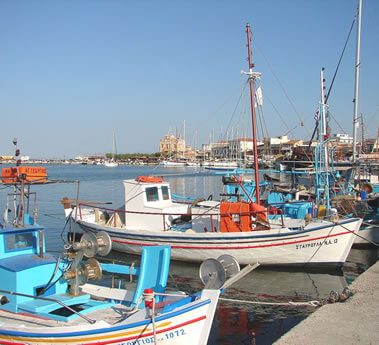
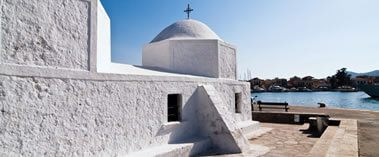
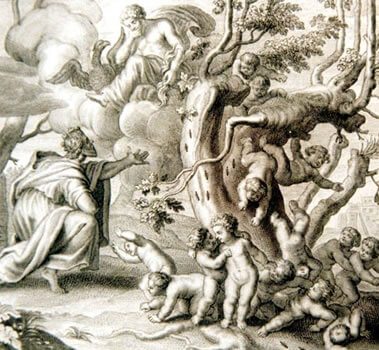
Mythology
According to an ancient Greek myth, Aegina was the loveliest of river Asopos’ twenty daughters. Zeus, father of men and gods, fell in love with her. He transformed himself into an eagle and carried her away from Flious (today called Ai-Georgis, East of Arcadia) to the then uninhabited island of Oinoni directly in the middle of their Saronic Gulf. The fruit of their love was Aeacus, who became the first and last king of the island that bore the name of his mother, Aegina (or Aigina).
Aeacus, who enjoyed undivided paternal love, became the great patron not only of his own homeland, but also the whole of Greece. He was also the founder of the family of Aeacides. According to one of the myths about the origins of Aegina’s inhabitants, Hera, Zeus’ wife, driven by the hatred for her rival, Aegina, sent her venomous snakes, poisoning the waters of the island and killing all its inhabitants. However, Aeacus managed to re-colonize the island by beseeching his father, Zeus, who transformed the ants of a sacred oak tree into men. They were named Myrmidons [this popular etymology of the name is incorrect, as the name Myrmidons (ancient, warlike people of Thessaly, subjects of Pileas and Achilles) and the word myrmidons (ant nests) sound the same, but are spelled differently in Greek]. Later, the Myrmidons colonized Fthis and were led by Achilles against Troy.
According to the myth, Saron was the king of Troezen, who built the temple of the goddess Artemis in Saronida. They say that he drowned himself while hunting a deer that threw itself into the water. People named that place after him, and it is still being called the Saronic Gulf.
Agios Nektarios
On Aegina’s main road leading to the inland, 6 km west of Aegina town is found the location Xantos, with a new-built large church and the old renowned monastery of Agios Nektarios. The nunnery is built over the ruins of the Byzantine monastery of Zoodoxos Pigi, opposite the medieval city of Paliahora where the miracle-working saint Agia Anastasia lived as a hermit in the 9th century.
Agia Triada was erected in 1904 and the foundations were laid by Agios Nektarios himself on 1st January 1906. At that time Agios Nektarios was still director of the Rizzarios School and the foundations were laid with the approval of the Metropolitan bishop, Theoklitos. When Nektarios resigned from his post in the ecclesiastical school he inaugurated his monastery (2nd June 1908) and retired there, where he spent the rest of his life in strict ascetic practice and prayer.
When the Saint died on 8th November his relics, were buried on the right side of the church, under a tall, deep-shaded pine tree. His grave and monastery remains to our days full of votive offerings and they are a place of religious pilgrimage, where thousands of devout believers flock daily to worship and begging his mediation for their physical health and spiritual deliverance.
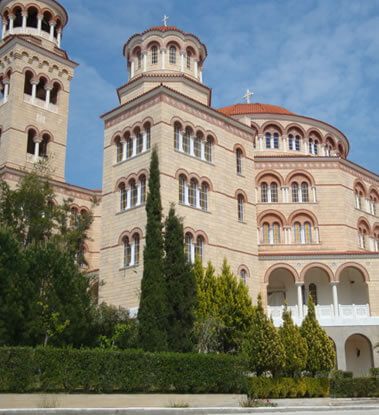
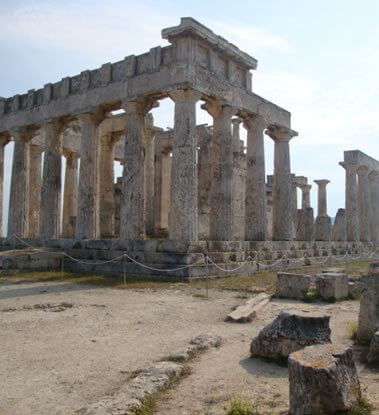
The Temple of Aphaia
The sanctuary of Aphaia is located at the northeastern tip of Aegina, overlooking the headland of Agia Marina, on a pine-clad hill offering a panoramic view over the sea. The site is known to have been a place of worship during prehistoric times (around 1300 BC), when it was associated with a female fertility deity, as we deduce from the finds dating back to prehistoric times (probably from the beginning of 2nd mellenium BC). The most prominent of these finds is the statuette of a female figure nursing a baby, which was brought to light through archaeological excavations.
Aphaia named Britomartis daughter of Zeus and Karme and a dear companion of Artemis.. Minos, king of Crete, loved Britomartis and to escape his attentions, she jumped into the sea. However, she became entangled in fishing nets. Artemis saved the girl from drowning and turned her into a goddess, venerated by the Cretes with the name Dictinna (translator ‘s note: the Greek word for nets is “dictia”). The Aeginitans believed that Britomartis emerged in Aegina, where she became invisible (translator ‘s note: the Greek word Aphaea means “invisible”) and lived in a forest. Thus, she was worshiped with the name Aphaea.
Remarkable is the fact that the distance (44,64 Km.) between the temple of Aphaea in Aegina and Acropolis of Athens is the same as the distance between the temple of Aphaea and the temple of Poseidon in Sounio (cape in Athens).
Hellenic Wildlife Hospital
At the foot of the hill descending from Lazarides, one comes across the Hellenic Wildlife Hospital (HWH). This is the first organization in Greece to obtain official permission to possess, treat, transport and release all species of indigenous wildlife.
Hundreds of volunteers from Greece and elsewhere have gained an unforgettable experience by taking part in different activities organized by the HWH. All those who are interested in contributing to wildlife protection and maintaining the cleanliness of the facilities can be put up by the HWH, where they may gain an unforgettable experience by working with the animals.
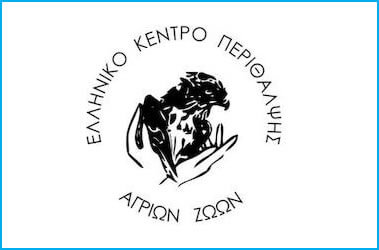
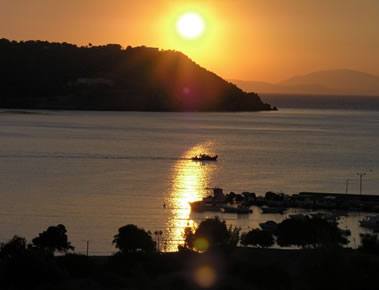
Agia Marina
The port of Agia Marina lies at a distance of three kilometers from the temple of Aphaia. There is regular traffic from here to Piraeus.
Until the middle of the 20th century, Agia Marina used to be a deserted seaside resort with many pine trees, vineyards, groves, a few rural houses and an old wharf. Today, it is a busy port and much-frequented tourist site, with numerous hotels, rooms for rent, restaurants and nightclubs.
Its name was derived from the old church of Agia Marina, which is located in the south part of the bay and is celebrated on the 17th of July. A long, sandy beach embraces the bay with shoal waters, On the left side of the bay the coast is rocky and ideal for underwater fishing.
Souvala
Souvala is Aegina’s second biggest port. In pre-Christian times it was called Oia and was used in later years by the citizens of Paliahora. In post-Byzantine years, it became the island’s shipyard.
The word “Souvala” means a man-made, usually open cistern and was probably given to the area because of the ancient, chiseled cisterns in the rocks by the mineral water springs located in Therma.
The name “Therma” and the few relics of ancient buildings reveal that these springs were already known in antiquity. Today the mineral water spring of Souvala is one of the best-known mineral water springs in Europe and is recommended for curing stomach disorders, rheumatism, skin and gynaecological ailments. It is a warm (25,9 Celcius), saline, slightly alkaline, bromide spa. A litre of water contains 8.5 g of magnesium chloride, 1.2 g of gypsum and other salts in smaller quantities.
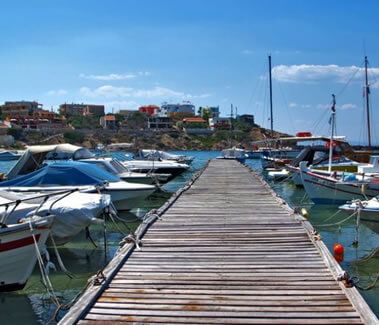
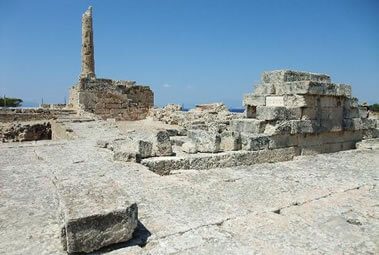
Kolona
The archaeological site of Kolona is situated very close to the harbour.
On the left of the disembarkation area and reflects the age-long history of the Acropolis of ancient Aegina.
Venetian sailors named the hill “Kolona” after the columns (kolon=column) of the ancient temple of Apollo that served as a sign of orientation.
Perdika / Moni
Perdika is a picturesque fishing village built around a natural harbour, protected by the wind, in the southwestern tip of the island.
Its name (Perdika in Greek means “partridge”) is derived from the numerous partridges of the woods that existed in the area before its development.
Archaeological excavations tell us that Perdika was inhabited during the Mycenean Age.
A mere ten minutes away from Perdika by boat lies the uninhabited islet off the southwest point of Aegina called Moni.
The small island derives its name from the monastery of Panagia Chrysoleontissa, but according to the renowned traveler R. Chandler the name means “isolated skerry”.
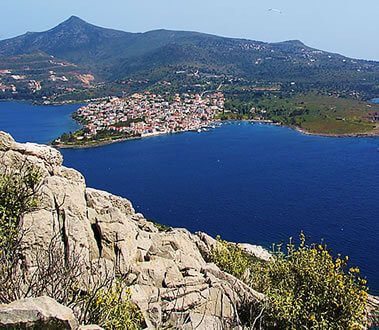
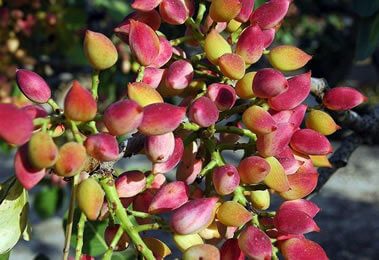
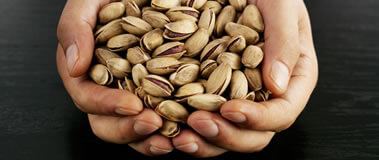
Aegina’s Pistachio Trees
Pistacia vera, one of the 11 varieties of the genus Pistracia, belongs to the category of Terebinthales of the family of Anacardiaceae. It is a deciduous, dioecious and protandrous tree; it is longevous, with a slow growth and reaches 4-9 meters. Its trunk and branches have an ashen-colored bark, which darkens in the course of time. The pistachio tree’s roothold is strong and can reach a depth of 3 meters and a width of 6-8 meters. It’s fruit is drupe, oval, pointed, with a woody endocarp, which usually opens during ripening, reveiling the seed.
The pistachio tree is the only deciduous tree planted with a ball of earth and requires little fertilizer, which influences to a great extent the fruit’s organoloptic abilities. Its cultivation is semi-xerophytic and is watered 2-3 times per year (July-August) with a little water, when the seed (flesh) appears in the spongy umbilical belt. Chemical pest control is very low scale and requires about 2 spraying sessions. Thus, the final fruit is totally clear of toxic traces.
The Aegina pistachio nut is considered by the European Community to be a product with protected designation of origin (PDO) according to Regulation No 1263/96 EC. The pistachio nut is greatly prized, since it has an exquisite taste and a unique aroma owing to the island’s climate and the composition of the soil, thus labeling it the best pistachio variety in the world.






